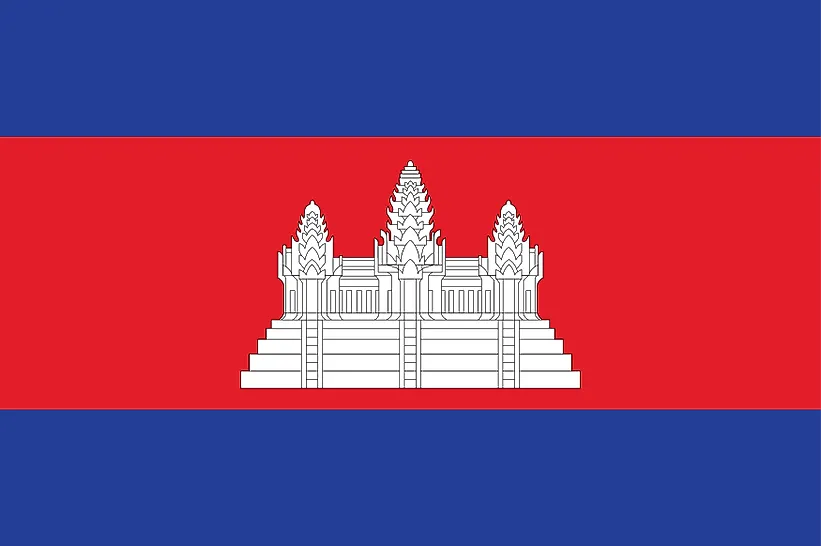
Cambodia
| Continent | Asia |
| Capital | Phnom Penh |
| Population | 15,957,223 |
| GDP | $58.94 Billion |
| GDP per Capita | $3,700 |
| Dialing Code | +855 |
| ISO Code (2-letter) | KH |
| ISO Code (3-letter) | KHM |
Cambodia Landscapes






About Cambodia
Welcome to Cambodia, a Southeast Asian nation where ancient temples rise from the jungle and traditional culture thrives alongside modern development. With approximately 16.7 million people occupying 181,035 square kilometers, Cambodia combines its spectacular Angkorian heritage with warm hospitality and a resilient spirit. Known as the “Kingdom of Wonder,” this country offers visitors an extraordinary journey through time, from ancient civilizations to contemporary Southeast Asian life.
Geographic Features and Natural Beauty
Cambodia’s geography is dominated by the Mekong River system and the Tonle Sap Lake, Southeast Asia’s largest freshwater lake. The central plains, which host most of the population and agricultural activity, are surrounded by mountain ranges and the Gulf of Thailand coastline.
The Tonle Sap Lake features a unique ecological phenomenon: during the monsoon season, the Mekong River’s flow forces the Tonle Sap River to reverse direction, causing the lake to expand dramatically and creating one of the world’s most productive freshwater fisheries.
The Cardamom Mountains in the southwest contain some of Southeast Asia’s most pristine rainforests, while the eastern provinces feature waterfalls, forests, and territories of indigenous peoples. The country’s coastline, though relatively short at 443 kilometers, includes beautiful beaches and tropical islands.
Cultural Heritage and Traditions
Cambodian culture is deeply influenced by Hinduism and Buddhism, with the latter remaining the state religion. The magnificent temples of Angkor, including Angkor Wat, the world’s largest religious monument, stand as testimony to the country’s rich architectural and artistic heritage.
Traditional arts, including classical dance, shadow puppet theater, and silk weaving, have been revived after near-destruction during the Khmer Rouge period. The Royal Ballet of Cambodia, recognized by UNESCO as Intangible Cultural Heritage, continues to perform ancient court dances.
Cambodian cuisine features complex flavors combining sweet, sour, salty, and bitter tastes. Fish from the Tonle Sap and Mekong River, along with rice, form the foundation of the diet, while dishes like amok (fish curry) and nom banh chok (rice noodles) are national favorites.
Historical Journey
Cambodia’s history spans from the mighty Khmer Empire, which ruled much of Southeast Asia from the 9th to 15th centuries, through periods of decline, colonial rule, and modern challenges. The Angkor period represents the height of Khmer civilization, leaving behind magnificent temples and advanced water management systems.
The country experienced French colonial rule from 1863 to 1953, followed by independence under King Norodom Sihanouk. The tragic period of the Khmer Rouge regime (1975-1979) devastated the country, but Cambodia has shown remarkable resilience in rebuilding and developing since the 1990s.
Modern Economic Landscape
Today’s Cambodia has one of Asia’s fastest-growing economies, driven by tourism, garment manufacturing, construction, and agriculture. Tourism, centered on the Angkor temples but expanding to include coastal and ecological destinations, is a major contributor to the economy.
The country has made significant strides in poverty reduction and infrastructure development, though challenges remain. The government’s “Rectangular Strategy” focuses on governance reform, private sector development, and human resource development.
International Relations and Global Position
Cambodia maintains active participation in ASEAN and various international organizations. The country has strengthened its regional integration while balancing relationships with major powers including China, the United States, and Japan.
Did You Know?
• Angkor Wat appears on Cambodia’s national flag, making it the only national flag featuring a building?
• The Tonle Sap Lake’s flow reversal is one of only two such phenomena in the world?
• Cambodia’s silk weaving tradition dates back to the 1st century, and the country is famous for its golden silk?
• The temples of Angkor were “rediscovered” by French naturalist Henri Mouhot in 1860, leading to major restoration efforts?
Conclusion
Cambodia represents a remarkable story of cultural preservation and national renewal. From its ancient temples to its modern cities, from its traditional arts to its developing economy, Cambodia continues to evolve while maintaining its unique cultural identity. As it faces the challenges of development and modernization, Cambodia remains committed to preserving its heritage while building a prosperous future for its people.